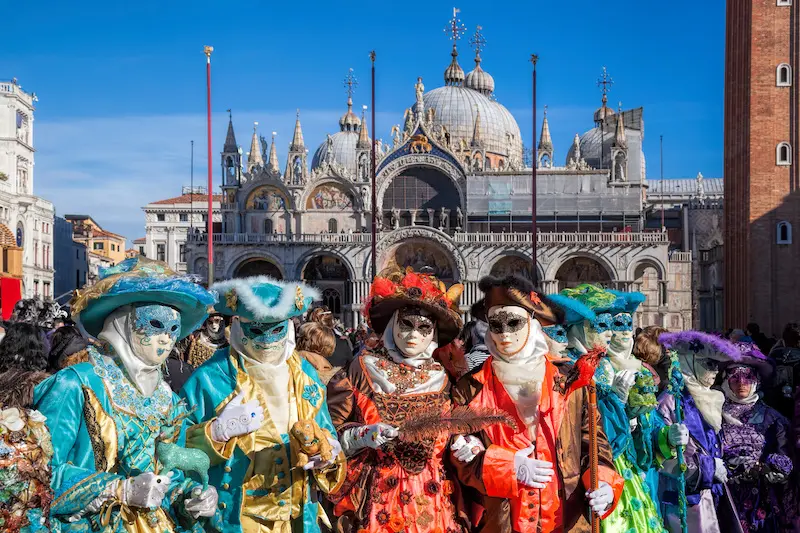The Venice Carnival (Carnevale di Venezia) is a world-famous festival celebrated in Venice, Italy, known for its elaborate masks, grand costumes, masquerade balls, parades, and street performances.
It’s a celebration of art, mystery, tradition, and freedom, drawing visitors from all over the world.
- Typically held in the two weeks leading up to Lent, culminating on Shrove Tuesday (Mardi Gras).
- The festival turns Venice into a grand stage of historical reenactments, music, dance, and costume parades.
Historical Background of the Venice Carnival
Origins in the Middle Ages (11th–12th Century)
- The first recorded mention of the Venetian Carnival dates back to 1094, in a document of Doge Vitale Falier.
- The term “Carnevale” comes from the Latin “carne levare” meaning “to remove meat”, referring to the practice of feasting before the Lenten fast.
Rise to Fame — 13th to 18th Century
- By the 13th century, Venice’s Carnival was established as an official celebration.
- The Venetian Republic (La Serenissima) promoted it to boost morale and allow citizens of different classes to mingle.
- Masks became a symbol of freedom, allowing wearers to hide their identity and social status.
- 16th–18th Centuries:
The Carnival reached its peak, with lavish balls, gambling, theater, and public festivities.
Venice became known for its extravagant parties and masked intrigues — a center of European carnival culture.
Decline and Ban — 1797
- After Napoleon Bonaparte conquered Venice in 1797, the Republic fell, and Carnival was banned.
- Authorities feared that masks encouraged rebellion and political dissent.
- Only small private parties survived.
Revival in the 20th Century
- In 1979, the Italian government and Venetian authorities officially revived the Carnival to boost tourism and preserve cultural heritage.
- The revival restored historical costumes, mask-making traditions, and public celebrations.
- Today, it’s one of Europe’s most celebrated cultural festivals.
Venetian Carnival Masks — Symbolism and Types
Masks are the heart of the Venice Carnival — representing mystery, anonymity, and freedom.
Famous Traditional Mask Types:
- Bauta:
Full-face mask with a prominent nose, strong chin line, worn with a cloak and tricorn hat.
Allowed the wearer to eat and drink without removing it. - Colombina:
Half-mask covering eyes and nose, often adorned with gold, feathers, and jewels. - Moretta (Muta):
Black velvet mask worn by women; had no mouth opening — held by a button inside the mouth. - Volto (Larva):
Simple white mask covering the full face — associated with classic Carnival disguise. - Medico della Peste (Plague Doctor):
Long beak mask originally used by doctors during the plague, later adopted as a symbolic costume.
How Venice Carnival is Celebrated Today
Grand Opening Events
- The festival opens with water parades on the Grand Canal, music performances, and fireworks.
Masquerade Balls
- Elegant private and public masquerade balls are held in palaces and hotels.
- Guests wear elaborate historical costumes and masks.
- Famous balls include:
- Il Ballo del Doge
- The Mascheranda Grand Ball
Best Mask Contest (La Maschera Più Bella)
- A highlight of the festival.
- Contestants in stunning masks compete for the title of “The Most Beautiful Mask.”
- Judged by an international panel.
Venetian Water Parades
- Gondolas and boats adorned with lights and decorations parade through the canals.
- “Festa Veneziana sull’Acqua” is the grand opening water show.
Street Performances and Parades
- Jugglers, musicians, dancers, and actors perform in Venice’s iconic squares like Piazza San Marco.
- Open-air theater, concerts, and street shows bring the city to life.
Artisan Markets and Mask Workshops
- Visitors can buy handcrafted masks from local artisans.
- Many participate in mask-painting workshops to create their own souvenirs.
Key Locations During Carnival
- Piazza San Marco (St. Mark’s Square):
The heart of Carnival events, mask contests, and performances. - Grand Canal & Rialto Bridge:
Hosts water parades and boat shows. - Palazzo Pisani Moretta & Palazzo Contarini:
Known for exclusive masquerade balls.
Venice Carnival 2025 Dates (Expected)
- February 22 – March 4, 2025
(Dates vary each year depending on Lent)
Cultural Significance
- Celebration of Freedom & Artistry:
Carnival historically allowed all classes to mingle under the anonymity of masks. - Preservation of Venetian Craftsmanship:
The event supports local artisans, costume designers, and mask makers. - Global Tourist Attraction:
Venice Carnival draws over half a million visitors annually, boosting the local economy.
Interesting Facts About Venice Carnival
- Venice masks are often hand-painted and made from papier-mâché.
- Some balls charge hundreds to thousands of euros per ticket.
- The Carnival is known for its Baroque-style costumes, echoing 18th-century Venetian fashion.
Criticisms and Modern Challenges
- Over-tourism:
The event draws massive crowds, raising concerns about Venice’s fragile environment. - Authenticity vs. Commercialization:
Some fear the Carnival has become too commercial, focusing more on tourism than tradition.
The Venice Carnival is a magnificent blend of history, mystery, art, and celebration, rooted in centuries of Venetian culture.
From its medieval origins to its grand modern revival, it remains a symbol of Venice’s unique identity and the timeless allure of masked elegance.
Whether you go for the spectacle, the artistry, or the experience, Venice Carnival is a festival like no other.
